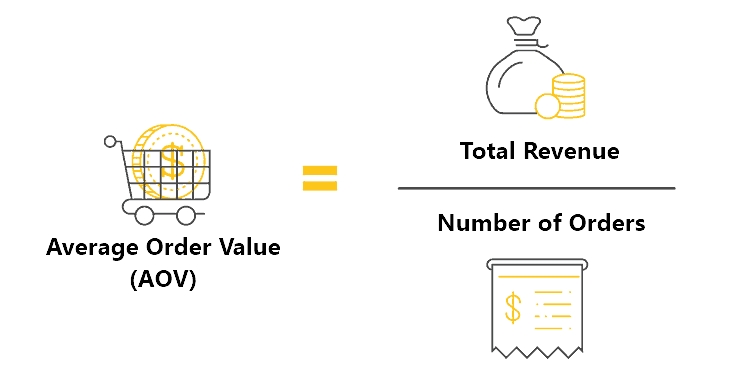AOV (Average Order Value) Definition
Average Order Value (AOV) is a crucial metric that gauges the average amount customers spend when placing an order on a website or mobile app. It offers valuable insights into customers’ purchasing behaviors. Typically, your store’s AOV tends to rise as customers opt for higher-priced items.
Similar to most other key metrics, average order value can be tracked over time to measure changes and growth, whether that is over a year, six months, or a few weeks. Most businesses follow their AOV monthly, however, for up-to-date readings that allow them to make frequent and necessary changes whenever the need arises.
How Do You Calculate AOV?

Calculating your average order value is fairly simple. All you have to do is divide the total revenue by the number of orders placed. The calculation is as follows:
- Average Order Value (AOV) = Revenue / Number of Orders
For example, over a period of two months, your online store’s sales were $74,000 and you had a total of 4,000 orders. When you plug these numbers into the equation, you end up dividing $74,000 by 4,000, which equals $18.5. This means that for these two months, the average order value for both was $18.50.
When figuring and monitoring AOV, you must also look at two other important metrics: lifetime revenue per customer and cost per conversion. Let’s break these metrics down further:
Lifetime Revenue Per Customer
Lifetime revenue per customer is the total value of each customer. This value actually indicates the average amount a customer will order from your business over time. If you find that this number is low, it means that your customers aren’t coming back to make more purchases. This means that you’ll find a lower return on marketing investment.
Cost Per Conversion
This specific metric measures the amount it costs your business to acquire customers. It is important to note that these must be paying customers, not just leads. When this number is determined, it should be subtracted from the average order value so that you can figure out the actual profit per order.
These metrics provide a clearer understanding of your AOV and how well your business is doing. Again, to improve your business, you should improve and increase your AOV. This can be done in a number of ways.

Why is Understanding AOV Important?
Knowing your business’ average order value helps you to evaluate how well your overall marketing efforts and pricing strategy are working. This metric is necessary to measure the long-term value of each individual customer, providing invaluable information for how to continue your marketing and customer outreach efforts.
AOV is often viewed as a benchmark of customer behavior, which helps your business set clear goals and strategies as well as to measure how well your strategies are actually working. With such clear and honest feedback, you can rest assured that you’re making the best decisions for your business needs.
It is important to note that in most cases, marketers focus much of their energy on increasing traffic to their website. However, it would be more useful and even profitable to increase their AOV instead.
Many methods used for increasing site traffic like paying for ads actually cost a lot of money and can take up much of your time, but increasing average order value can be quick, direct, and inexpensive. Since there is a transaction cost linked with every order, upping your average order value is a great way to push direct revenue and increase your overall profits.

How Do You Improve Your AOV?
If you find that your AOV, including lifetime revenue per customer and cost per conversion, is low, you need to do some work to improve it. There are some strategies you can adopt that will improve your AOV, making your business stronger overall.
You can improve AOV by customer segmenting. This practice simply involves businesses segmenting their customer base depending on purchase history or frequency. You then divide customers into groups (think those who spend a small, medium or a large amount of money per purchase), and then fine-tune your marketing strategies to fit these customer categories.
Customers who spend a small amount each purchase may be targeted with coupons, sales, and other offers, while those who spend a large amount may be targeted with rewards programs and loyalty perks. It’s all about meeting your customers where they are to build a relationship with them and entice them to grow their bond with your business.
You can also improve your AOV by incorporating some (or all) of the following strategies for different customer segments:
Upselling
This involves offering a product or service that is only slightly more expensive than something your customer has already purchased. Usually, the offer is for something “only $10 more” or thereabout, showing that customers spend just a little more, they get more bang for their buck.
Cross-Selling
Cross-selling is a little like matchmaking. Did your customer buy a content management system from you? Why not add on some plug-ins that will definitely come in hand for extra coverage? Pairing items that complement each other can lead to bigger sales.
Free-Shipping
This is usually offered when a minimum purchase is reached. It allows shoppers to spend a little more so that they can save some.
Return Policy
For your costlier goods and services, a return or “money-back” policy fosters trust amongst customers and takes some of the stakes out of buying more expensive products or services.
Coupons
Coupons are always a great offer to bring customers back for another purchase. If you offer a coupon that promises $10 off on a customer’s next purchase, they’re much more likely to shop with you again.

Implementing some or all of these strategies can almost guarantee a positive change in your AOV in just a matter of time. AOV is all about your customers, but there is more to customer retention than just perks and rewards.
You want your business to have a strong relationship with your customers, especially online. This means ensuring that your website is as good as it possibly can be for the average visitor, potential leads, and paying customers. Let Directive boost your AOV through our cutting-edge PPC and SEO strategies.